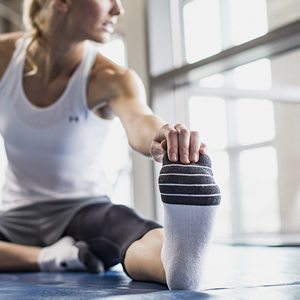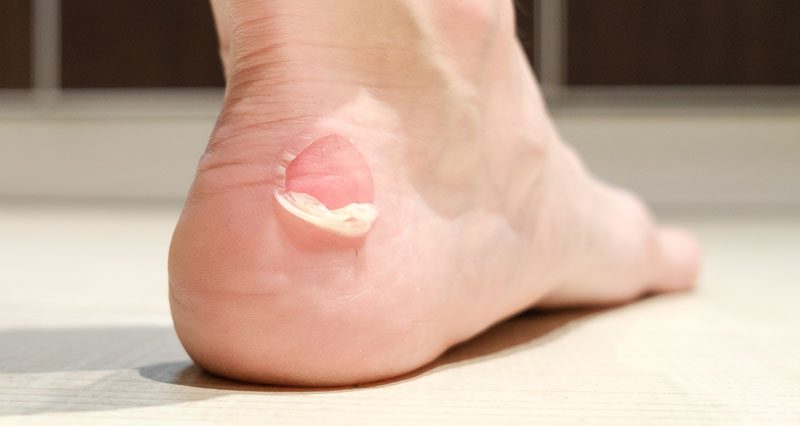Running socks are the only thing between your running shoe and your foot. It is essential to what socks you use when running, as this can help prevent blisters. I will tell you the 3 features a running sock must have to avoid blisters. If your running socks contain at least two of these three features, your feet will be safer from blisters.
The most important features to prevent blisters during running are that the socks are cushioned, absorb moisture, and each toe is in its own place (toe socks). You will reduce blisters during running by keeping your foot dry for as long as possible. And you’ll reduce the friction of your foot rubbing against the shoe.
In the following part of this post, I will explain what socks are best to wear while running to prevent blisters. And what is probably the reason for the sudden appearance of blisters?
what are the best running socks to prevent blisters?
The best-running socks to prevent blisters during running are cushioned, absorb a lot of sweat and keep the toes in a separate place. Socks should keep the foot dry and should be padded at the toe area and around the ankle to prevent the back of the foot from rubbing against the shoe.
In my opinion, there are three features of running socks that contribute most to preventing blisters:
- Running socks are cushioned in the toe area and around the ankle,
- running socks are made of absorbent materials that soak up a lot of sweat and keep the foot dry,
- Toe running sock arrange each toe to its own separate place to prevent toes from chafing.
1. Use cushioned/thick running socks to prevent blisters
The foot is constantly rubbing against the shoe while running, which sooner or later affects the health of our feet. Especially if you regularly run long distances. The quality of running shoes is important for foot health in the first place, as shoes are the only surface that keeps our feet off the ground.

Another important piece of running gear is running socks. If you use thicker/cushioned socks, your feet will become tired later, and you will find it easier to run longer distances. Cushioned running socks are usually made of wool, a comfortable material that absorbs a lot of sweat. It is, therefore, ideal for long-distance running socks and is also used by professional marathon runners. You can read more about which socks to choose for 10k, 21k, and marathon distances here.
2. Use sweat-absorbent Running Socks to prevent blisters
When running, the foot should stay dry for as long as possible because blisters, calluses, and athlete’s foot develop more quickly in wet feet. The materials of running socks are the most important for keeping the foot dry. Most running socks are made of polyester, which is a synthetic material. Often, elastane and nylon are added. These materials are popular because they breathe well, but synthetic materials absorb almost no moisture, except nylon, which absorbs moisture well.
For runs of less than one hour or less than 10 kilometers, these socks are also good as the foot will not be in a wet environment for long periods of time. However, running socks made of absorbent materials such as wool and nylon are better for longer runs. Nylon adds elasticity to wool, while wool is comfortable and soft. I recommend you read a more detailed comparison of the five running sock materials to help you decide on your next purchase.
3. Try Toe running socks to prevent blisters in the toe area
Toe socks are a special type of running sock that positions each toe in its own place, unlike regular socks. These socks look like a glove for the foot because each toe is in its own place, and therefore the toes rub less. And the greater amount of material between the toes ensures more sweat is absorbed during the run.

You can find out what the advantages of toe socks over regular running socks are in this post. I also presented some of the brands of toe running socks that suited me best.
Why am I suddenly getting blisters when running?
The reason why you suddenly get blisters while running could be new running shoes that haven’t worn out yet, or it could be worn-out running socks. Socks can get thinner as you wear them, develop holes, are not tight enough, or are made of the wrong material (cotton).
Socks that are too thin do not provide enough comfort for the foot, and rubbing the foot against the running shoe is not well cushioned. After prolonged wear, worn running socks can develop holes, which is the last sign that the socks need to be replaced.

Another reason for the sudden development of blisters is that the socks do not fit snugly enough against the foot and wrinkle during the run, causing blisters.
The last reason could be choosing the wrong material for your running socks. If you run longer distances and your foot is in a moist environment for longer periods of time, this can lead to blisters, fungus, and athlete’s foot.
Choose a comfortable material, as this will greatly impact your comfort while running. You can read more about why cushioned socks make a difference here. This material should also be absorbent (wool, nylon) but never run in cotton socks. Cotton also absorbs a lot of moisture, making it wet and keeping the foot in a moist environment. Wool and nylon absorb moisture and keep your feet dry.
How do you prevent blisters when running?
Using good quality running socks and slowly walk-in new running shoes, you can prevent blisters while running. If your foot sweat a lot and you run long distances, you can apply talcum powder to your foot, which will reduce the chances of your foot getting too wet.
